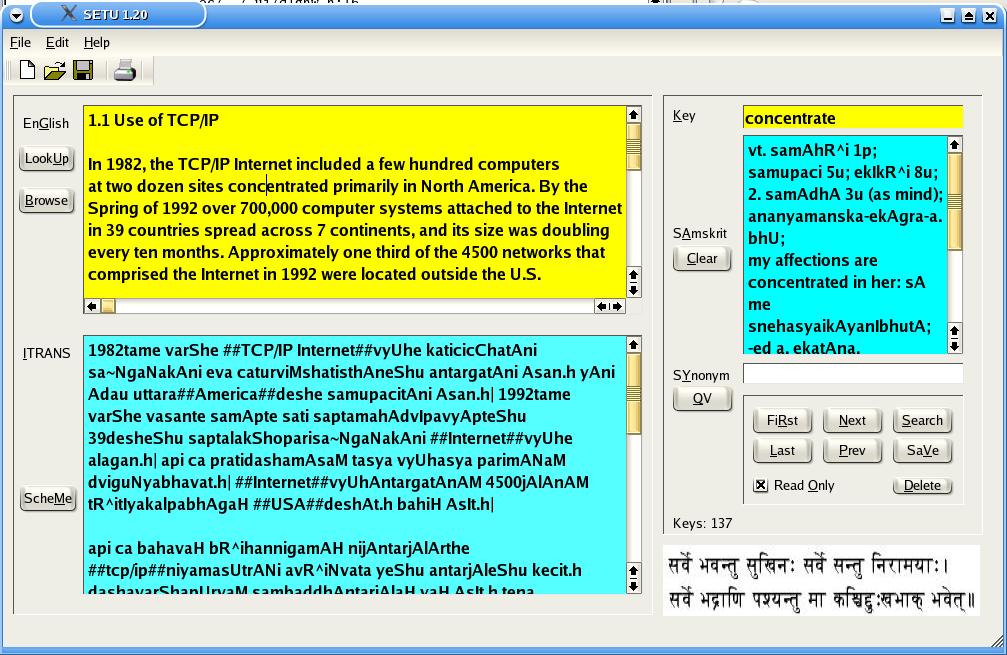Vowels:
a aa / A i ii / I u uu / U
R^i R^I L^i L^I
e ai o au aM aH
Consonants:
k kh g gh ~N
ch Ch j jh ~n
T Th D Dh N
t th d dh n
p ph b bh m
y r l v / w
sh Sh s h L
x / kSh / kS GY / j~n / dny
R (for marathi half-RA)
L (marathi LLA)
Consonants with a nukta (dot) under them (mainly for Urdu devanagari):
k with a dot: q
kh with a dot: K
g with a dot: G
j with a dot: z
p with a dot: f
D with a dot: .D
Dh with a dot: .Dh
ph with a dot f
Specials/Accents:
Anusvara: .n / M / .m (dot on top of previous consonant/vowel)
Avagraha: .a (apostrophe; `S' like symbol basically to replace a after o)
Ardhachandra: .c (for vowel sound as in english words `cat' or `talk')
Chandra-Bindu: .N (chandra-bindu on top of previous letter)
{\m+} chandra-bindu with virama
Halant: .h (to get half-form of the consonant - no vowel - virama)
Ra ligature: ^r (top curve as in ii to get r sound, half r)
(^r put after the intended consonant, e.g u{dhva}^r)
Visarga: H (visarga - looks like a colon character)
Om: OM, AUM (Om symbol)
Svaras: \` udaatta (upper svara) (`= 096; not apostrophe)
\`` double udaatta (double upper svara)
\_ anudaatta (lower svara)
Following older codes are also accepted:
kSh (= ksh)
~n (= JN)
~N (= N^)
dny (= GY)
^r (= .r)
Sh (= shh = Z = S)
Ch (= chh)
c (= ch)
To prevent the formation of ligatures you may insert {} between characters. E.g. kla converts to the kla ligature k{}la converts to half ka + la.
For more details on ITRANS 5.1 see http://www.aczone.com/itrans.html
Abbreviations used in the Dictionary:
- A Atmanepada
- a. adjective
- abl. ablative
- acc. accusative
- adv. adverb
- arith. arithmetic
- bah. bahuvrIhiH
- c. causal
- circum. circumlocution
- comp. compound
- conj. conjunction
- d. denominative
- dat. dative
- deriv. derivative
- desid. desiderative
- ex. expressed
- f. feminine
- fig. figurative
- freq. frequentative
- gen. genitive, generally (when followed by ex.)
- gen. abs. genitive absolute
- ind. indeclinable
- inf. infinitive
- instr. instrumental
- interj. interjection
- lit. literal, literally
- loc. locative
- loc. abs. locative absolute
- m. masculine
- math. mathematics
- n. neuter
- nom. nominative
- p. parasmaipada
- part. participle
- pass. passive
- pot. potential
- pot. pass. part. potential passive participle
- pl. plural
- pr. prefixed
- prep. preposition
- pron. pronoun
- pron. a. pronominal adjective
- q. v. quod vide
- s. substantive
- sim. comp. similar compound
- tat. tatpuruSha
- u. ubhayapada (Atmanepada and parasmaipada)
- v. verb (transitive and intransitive)
- v.i. verb intransitive
- voc. vocative
- v.t. verb transitive

